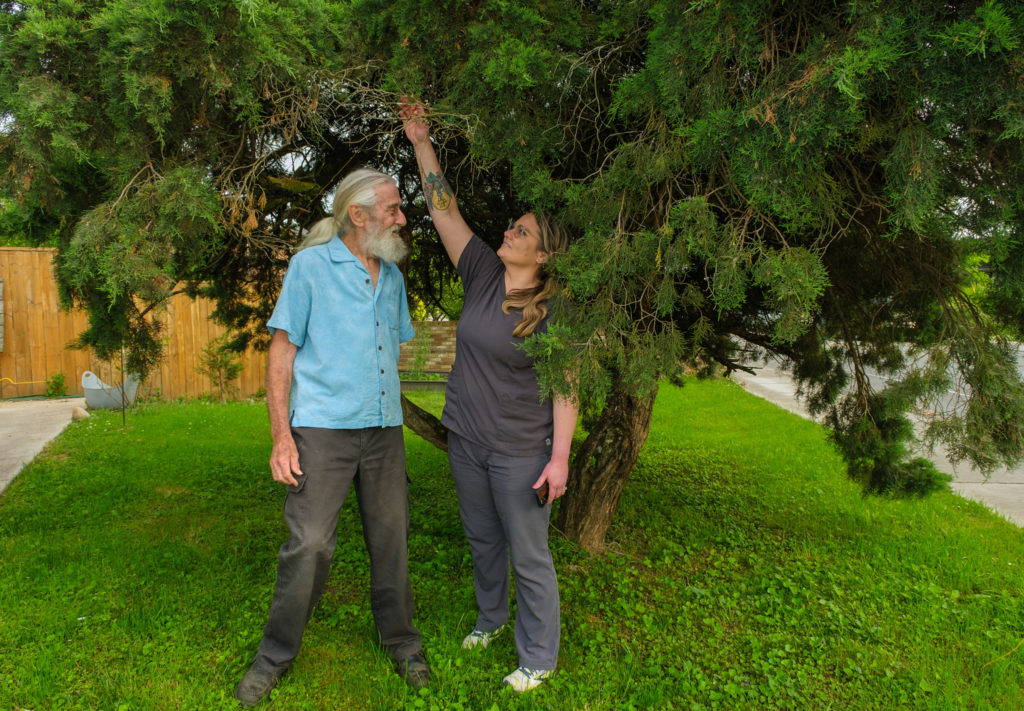
There are many Nashville neighborhoods with a hidden history behind them.
Sometimes, discovering that history helps neighbors explain how a popular restaurant or local park got its name. Other times, it helps a person make sense of a strange tree blooming outside the window of their home.
This is what prompted Liz Cannon to contact our Curious Nashville project. She wanted to know the history behind the “bonsai-looking cypress tree” in her backyard and took it upon herself to do some investigating.
North Nashville is a place that has a lot of trees. Take a stroll down Buchanan Street, however, and you’ll eventually stumble upon a strange looking evergreen.
“This is definitely the biggest,” says Cannon, pointing to the tree. “I think I saw one down 28th that was similar in shape, but it was not nearly as big.”
What is this strange tree?
The evergreen tree has pokey leaves that resemble tiny branches. They hang down like they’re coated in green icicles. The leaves help camouflage a bird’s nest on its large brown and bendy tree trunk.
 Caroline Eggers WPLN News
Caroline Eggers WPLN NewsSpider webs coat the leaves of Liz Cannon’s wacky backyard tree.
“In the winter, this is like bird city,” she says. “My husband will throw out bird seeds over here if it snows because they can’t get seeds and worms.”
The tree was first put on Cannon’s radar by Charles “Charlie” Fenton, her neighbor.
“They were fascinating,” Fenton says. “I’m sure it comes off of some distant land.”
Fenton says there are about a half-dozen scattered along nearby streets — but he’s not sure what to call them.
“Are these the trees that they trim into little miniatures?” he asks Cannon. “So, if it was left alone, it would be this big?”
The word he’s looking for is “bonsai.” It’s a practice that originated in China. The term was named in Japan and describes a way of growing trees. It’s basically an art form.
It’s a skilled process. Here’s how it works:
First, a good bonsai is often a juniper tree — like the evergreen outside of Cannon’s home.
Second, the trees are grown in small pots, pruned and require a lot of care to maintain.
A bonsai is simply a manipulated tree that grows into its normal shape as a miniature. They commonly range from an inch to 3 feet tall. What that means is: If you plant a seed from a bonsai without manipulating it, it’ll grow into a normal tree.
How did it end up in North Nashville?
Cannon became curious about the strange tree after moving to North Nashville in 2018.
“I think it was the first time I met Charlie. He came over, and he wanted to tell me about the tree and how he looks at it from his porch,” she says.
“Oh yeah, my whole romantic story,” Fenton replies with a quick laugh.
Cannon started digging for clues when the pandemic hit. She’s a nurse and was homebound to keep from getting infected with COVID. She decided to spend her time searching newspaper archives and researching maps to find out who planted the tree. She landed at a floral business that once stood where she now lives.
 Caroline Eggers WPLN News
Caroline Eggers WPLN NewsThe juniper tree in Cannon’s backyard is one of about a half-dozen scattered throughout her North Nashville neighborhood.
Traveling back in time
It’s the early 1900s. E.S. Pinckard, who was born on a farm south of Murfreesboro, had already spent nine years as a fireman and railroad engineer.
He decides to move to Davidson County and becomes the superintendent of a longstanding Jewish cemetery in North Nashville.
More: Nashville’s Jewish Cemetery, An Often Overlooked Reflection Of Religious History
“By 1920, I think, he had started his own greenhouse here,” Cannon explains.
Pinckard buys up some land and jumps into the nursery business. He’s all about evergreens and shrubs, famously taking evergreens and ornamentals that bloomed in the soil of Tennessee’s mountains and growing them in Nashville. He shipped them around the world.
Cannon found that Pinckard had a store on West End. But his main operation — with seven greenhouses — was in North Nashville on Buchanan Street. In 1940, he was hired by the city as head gardener of the municipal airport.
 The Tennessean Newspapers.com
The Tennessean Newspapers.comE.S. Pinckard
“2615 Buchanan back in the 20s and 30s was an evergreen nursery,” she says, “which puts us where we’re standing, because this street wasn’t here.”
She then found that the juniper tree in her backyard could be about 100 years old, based on its trunk. She’s not 100% sure there’s a connection to Pinckard, whose tree hub has been replaced mostly by homes, but through the process of digging, she has learned a lot about the history of her neighborhood.


